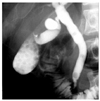Pancreatitis
Article information
Abstract
Pancreatic inflammatory disease may be classified as acute pancreatitis(AP) and chronic pancreatitis(CP) by primarily clinical criteria, with the obvious difference between them being restoration of normal function in the former and permanent residual damage in the latter. Gallstones and alcohol are the most common causes of acute pancreatitis. Abdominal pain is the major symptom. The diagnosis of AP is usually established by the presence of an increased serum amylase and lipase. CT scanning is the imaging method of choice in determining the severity and complications of AP. There are no generally recognized specific treatments for AP. Supportive therapy, which includes vigorous intravenous hydration, ample analgesia, and vascular, respiratory, and renal support as needed, remains the mainstay of therapy. CP may present as episodes of acute inflammation superimposed on a previously injured pancreas or as chronic fibrotic damage with persistent pain or malabsorption. Alcoholism is the most common cause of CP. The classic triad of pancreatic calcification, steadtorrhea, and diabetes mellitus usually establishes the diagnosing CP. ERCP and pancreatic function test are gold standard imaging procedures for diagnosing CP and planning treatment. Therapy for patients with CP is directed toward major problems such as pain, malabsorption, and diabetes mellitus. Pancreatic enzyme replacement therapy improves the abdominal pain and malabsorption. If complications is found, endoscopic or surgical treatments should be considered.




